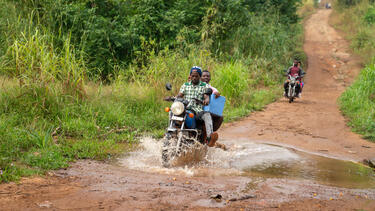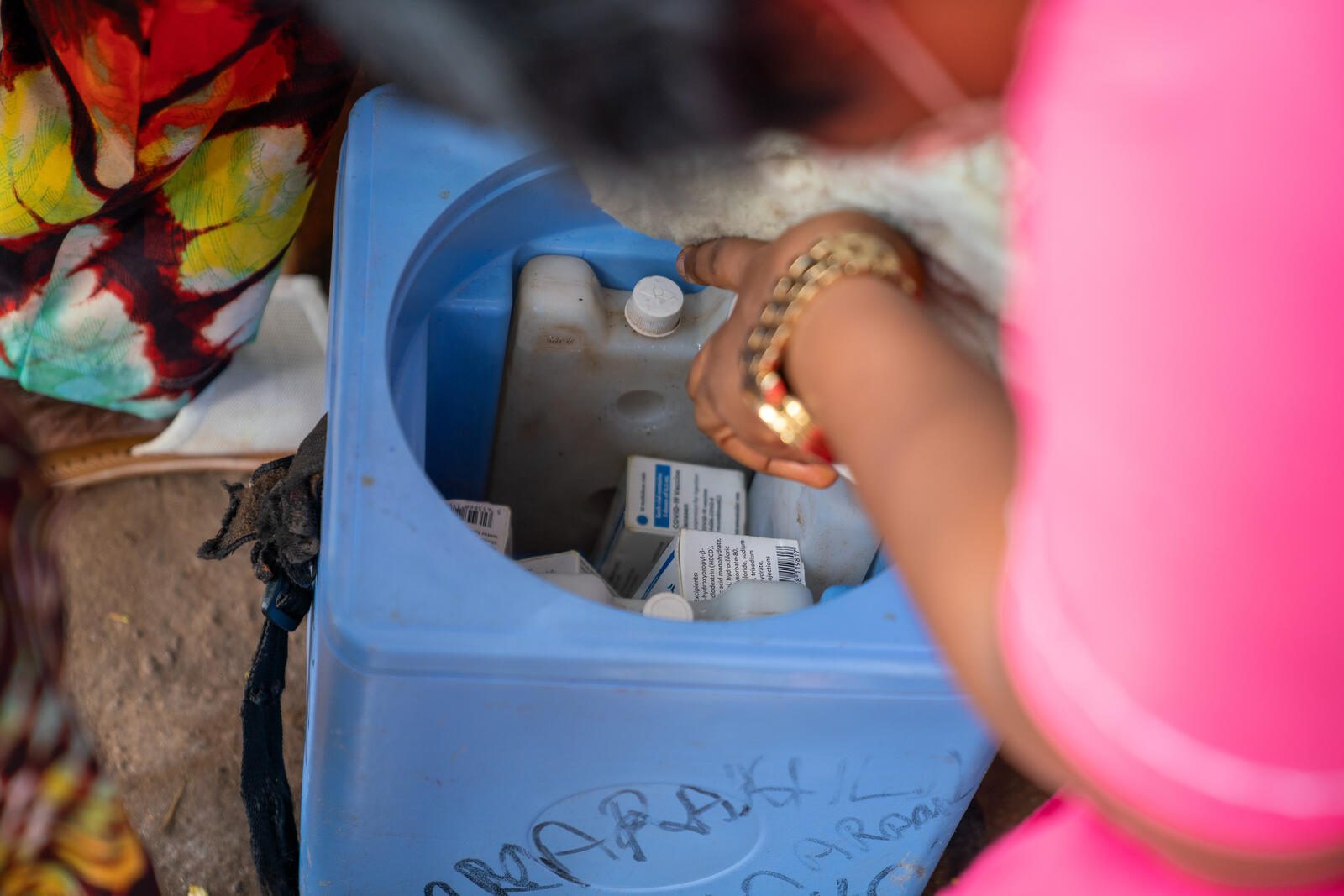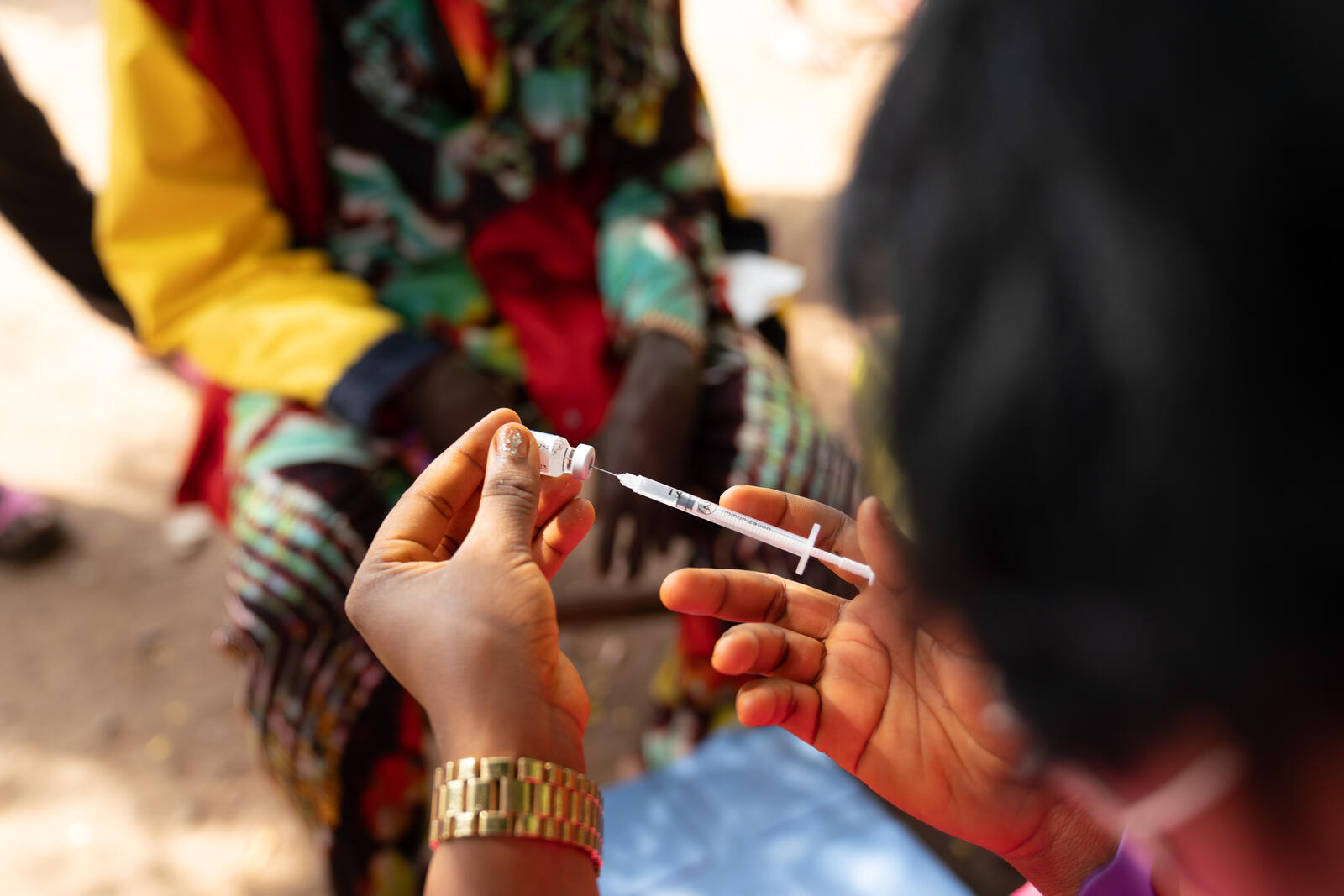Going the Last Mile (with Evidence)
In 2022, COVID-19 vaccination rates in remote areas of Sierra Leone were in the single digits, even as majorities in the developed world received second and third boosters. Yale’s Mushfiq Mobarak and his colleagues investigated what it takes to get the vaccine to more people in the developing world. The short answer? Nurses on motorbikes with vaccine-stocked coolers—along with basic community mobilization. Their rigorous study shows that it is possible to get health interventions to the most remote and under-resourced areas cost-effectively, in ways that help ensure that the interventions are taken up and used.

In the spring of 2022, a team of economists and public health researchers led by Mushfiq Mobarak, Niccolò Meriggi, and Maarten Voors spent weeks bumping along rough, gullied roads in rural Sierra Leone. It was hot and humid, but at least it was the dry season: Sierra Leone has the highest annual precipitation in West Africa, and most roads are unpaved, so when the downpours come, the roads become mud-slathered, tire-trapping impasses.
The trio of development economists were often in Meriggi’s car when they traveled; he’d been living in the capital city, Freetown, for more than seven years and knew his way around best. They were acting both as the principal investigators of a large public health experiment and as its scouting team. It was two years into the COVID-19 pandemic, and only 8% of Sierra Leoneans had received a COVID vaccine. They were testing out an effort to increase those numbers. Time was of the essence; Ramadan was coming in May, and many Muslims would be unlikely to take a vaccine during fasting hours.
The further they got from Freetown, the farther the distances stretched between villages. Most of Sierra Leone’s roughly 8 million residents live in widely dispersed rural communities.
“You can drive for three or four hours without encountering a town,” says Mobarak, a professor of economics at Yale. “And the ones you do encounter are tiny—just a few shops, maybe a pharmacy. Some towns have a restaurant and a rest house.”
For the average Sierra Leonean, it takes three and half hours each way and 10 days of wages to go to the nearest vaccination center. If you and I were under those conditions, we wouldn’t get a vaccine either.
They bunked in one village rest house or another, paying about $10 a night. It was an extra $10 if they wanted to run the generator to power the lights or a fan.
Their itinerary was dictated by their experiment. The researchers had randomly selected 150 rural villages to visit, each of which fell outside of the purview of the national network of clinics known as peripheral health units (PHU), where at least some Sierra Leonians received vaccinations. The average village in the study had about 50 households and 100 residents. Of the villages in the study, 100 would receive an intervention, and the other 50 would not, serving as the control.
The intervention was simple in concept: bring COVID vaccines to each village.
It wasn’t an original idea; WHO and CDC guidelines highlight the importance of “bringing services closer to the people.” And yet as measured by a dismally expansive variety of metrics, low-income communities across the world are systematically under-serviced. This simple idea was often poorly implemented, if it was attempted at all. In addition, according to a paper Mobarak and his co-authors published in the journal Nature, a disproportionate amount of research into how to improve vaccination rates has focused on demand-side questions, such as how to overcome vaccine hesitancy—the question of greater relevance to the United States and other rich regions where supply-side challenges have been addressed. But those challenges remain very relevant in developing regions.
Working with the Ministry of Health and Sanitation (MoHS), the researchers were attempting to change that in Sierra Leone. They had come up with a plan to quickly increase vaccination rates under difficult conditions in remote communities—and do it on the cheap. Now they had to test if it would work.

COVID-19 vaccines became widely, but not equally, available in early 2021. In the first six months of vaccine distribution, more than 90% of all doses went to high- and upper-middle-income countries, including the United States, Canada, and many European Union nations.
Meanwhile, billions in the global south got none. Only about one-fifth of Africans were vaccinated by mid 2022. Even now, as residents of wealthy nations get their fifth or sixth boosters, these chasms have persisted, especially in Africa.
Mobarak, the Jerome Kasoff ’54 Professor of Management and Economics at Yale University, was keenly aware of the disparities. As a development economist, he explores ways to influence people in developing countries to adopt technologies or behaviors that are likely to improve their lives. And as a lead academic with the International Growth Centre (IGC), he works with policymakers in these countries to promote policies that foster inclusive and sustainable growth. (Meriggi is the IGC country economist for Sierra Leone, and Voors is an associate professor at Wageningen University in the Netherlands.) Mobarak conducts field experiments to both test approaches and understand the logistics of scaling up the successful ones. He founded the Yale Research Initiative on Innovation and Scale to study how to scale up the most promising ideas.
African researchers, officials, and policymakers charged that rich countries initially withheld vaccines, and later prioritized getting boosters to their own citizens rather than first doses to Africa.
Pharma companies countered that vaccine hesitancy in poor countries was so pervasive that even when doses were sent to Africa, they sat unused, and were therefore wasted.
But a 2021 study by Mobarak, Meriggi, and a large team of collaborators had found that “in every single poor country, vaccine hesitancy is actually lower than it is in the United States,” Mobarak says. In the study, published in Nature Medicine, the researchers asked 45,000 people in 10 low- and middle-income countries, as well as in the U.S., how eager they were to get a COVID-19 vaccine once it became available. Vaccine skepticism was highest in Russia, followed by the United States.
There are certainly vaccine skeptics in various African countries, but were they really the primary cause of the abysmal 12% COVID vaccination rate across the continent? Mobarak and his fellow researchers kept landing on the same idea: supply-chain breakdowns in rural countries with limited distribution infrastructure contributed to the low numbers. Vast distances between small settlements, combined with limited roads, transportation, fuel, and funds, and topped off by the cold-chain conditions needed by COVID vaccines, curtailed how far and fast they could travel, often dooming them to demise.
The answer to this so-called last-mile challenge seemed self-evident: they needed to improve the way that vaccines were brought to the people.

Sweaty and dusty, the research team visited every home in the 150 towns to get a population count. In all, they logged 29,587 people.
Shortly after the data collection units left a village, a four-person social mobilization team coordinated by the Sierra Leone MoHS showed up. Team members, at least one of whom spoke the local dialect, organized a conversation with all village heads—town chiefs, women leaders, elders and youth leaders, religious figures.
The team explained they were there to give COVID-19 vaccines to those over age 12 who wanted them and asked leaders to hold a community meeting that evening to allow the team to talk directly to everyone about vaccine efficacy and safety and to address questions and concerns.
The next day, a pair of nurses arrived. Some arrived by motorbike, while others stepped off small boats or from battered cars. All carried coolers stocked with COVID-19 vaccines—AstraZeneca Johnson & Johnson, Pfizer, Sinopharm.
They quickly set up a temporary mobile clinic in a central village location and offered vaccinations from sunrise to sunset. All the while, the social campaign continued. In 50 randomly chosen villages from the treatment sample, the social mobilizer stopped by people’s homes to encourage them to get vaccinated. In the other 50, they sought out groups of people: women washing clothes near the river, people sipping tea at ataya shops or playing a game of checkers in the shade, the devout emerging from a mosque or church.
Shots went into arms for the next two or three days. A data collector logged everything. Then the team packed up shop and moved to the next treatment village. The data collection team then circled back to the village to survey the residents about their knowledge of and trust in vaccines.
They repeated this entire process 100 times. They got turned away only four times.
The results were striking. In treatment vilages, vaccination rates increased from 9.5% to 30.2% and vaccination counts by over more than 500. Word spread of the availability of the COVID vaccine beyond the villages, so people from neighboring communities showed up for shots too, doubling the total number of people vaccinated. And it only cost $32 per person vaccinated.
To Mobarak, this was evidence of the effectiveness of their strategy for solving the last-mile delivery problem. It wasn’t that people in these rural towns didn’t want COVID vaccines; it was that they were too far from them.
“At the time vaccines became available, the average Sierra Leonean would take three and half hours each way to go to the nearest vaccination center,” he says. Time spent traveling also means missing work. “The amount of money it costs to take such a trip is about 10 days of wages,” Mobarak says—a financial hit virtually no one can afford. “If you and I were under those conditions, we wouldn’t get a vaccine either.”
Mobarak and team argue in their paper published in Nature that these results “serve as a proof-of-concept that it is possible to cost-effectively vaccinate residents of the most remote places.”
None of this would have happened without meaningful collaboration from the Sierra Leonean government and study co-author Dr. Desmond Kangbai, director of the Expanded Program on Immunization in the Sierra Leone Ministry of Health & Sanitation.
“He’s experienced in doing vaccination programs, and he was really instrumental in guiding us about how to get things running on the ground so that they would be successful,” Meriggi says.
Kangbai, an epidemiologist, orchestrated the deployment of the vaccine mobilization teams, who all came from Sierra Leone’s system of community healthcare workers that are embedded in PHUs all over the country.
“When we got COVID, we made use of existing structures to train them on COVID messages,” Kangbai says.
Social mobilizers have long played a key role in community engagement, Kangbai says. “They are the ones who we call when outreach services are about to happen, like introducing new vaccines. They are the ones that go around the communities with the megaphones talking to people. They have to fit within the local traditions, so they use the local language, and people always accept what they say because they are trusted. They are a key part of the healthcare system.”
They’d proven especially useful in helping to control the Ebola outbreak of 2014–2016, in which nearly 4,000 people died. Of the three countries in which the virus was widespread, Sierra Leone had the lowest infection-to-death ratio. “We found out that it was a very important intervention,” Kangbai says.
Because the goal of the COVID vaccination study was to create an evidence-based intervention that would improve vaccination rates in Sierra Leone—and if it worked, elsewhere—accurate data collection was key.
That’s why the data collector played such an important role on the vaccine team. Some had tablets on which they could directly enter the data for upload to the Ministry of Health, but most had to hand-record on paper and then upload the data as soon as they had internet access. Back in Freetown, Kangbai and his team analyzed the raw numbers.
“When we are a part of conducting the research, it’s easier for us to adopt the findings and lay down a policy,” Kangbai says. “We want data we can use for action.”
And that’s exactly what the Sierra Leone Ministry of Health did, implementing strategies from the study within months of the economists’ road trip. In summer 2022, they deployed 1,400 vaccination squads across the country with the goal of vaccinating 70% of the population by year’s end. The teams cross rivers and climb mountains to visit remote communities. They sometimes navigate the dense byways of city slums too.
As of now, more than 9.1 million COVID doses have been administered in Sierra Leone—more than 1 per person. The numbers pale in comparison to the vaccination-plus-multiple-boosters rates in developed countries, but it’s a vast improvement over the 8% vaccination rate that the country had when the researchers began their study.
Kangbai says that based on the study’s findings, the health ministry has begun bundling COVID vaccinations with two priority campaigns: HPV vaccination for girls aged 10–12 and routine immunizations for children under six. The study revealed that transportation to reach remote communities is the biggest component of costs; the implication that naturally follows is that bundling multiple health interventions and delivering them at the same time could significantly reduce costs per person treated.
The Social Science Research Council took notice of this conclusion, and recently awarded the research team a $672,000 grant through its Mercury Project to scale up the results by bundling multiple maternal and child health interventions and bringing them to remote areas in Sierra Leone.
The researchers hope that the hours spent on bumpy dirt roads will lead to programs that benefit people across Sierra Leone and across the global south.
UNICEF has taken notice of the study. Gloria Lihemo, a social and behavior change specialist who coordinates UNICEF’s global demand for immunization interventions to promote the uptake of COVID-19 vaccines, says, “The key takeaway for us is that they were able to quantify the cost to actually access vaccines for rural communities. Their study provides an example of the payload that comes from using simple interventions—taking the vaccines to where the people are, and how that impacts uptake. They also tried to understand what the community’s concerns are, and immediately following that up with having people come in with motorbikes to actually provide the vaccines. All of this helps to improve the operational aspects of how vaccine delivery is done.”
The organization plans to bring together researchers and stakeholders who might be able to implement the economists’ strategies in other countries.
Mobarak says replicating their last-mile delivery solution in communities across sub-Saharan Africa, where the majority of people live in rural areas, holds enormous potential for achieving vaccine equity—not just for COVID but other diseases as well.
And rather than pointing fingers at vaccine hesitancy, he adds, pharmaceutical companies can underwrite programs like the one they tested in Sierra Leone, which was supported by the NGO Concern Worldwide. “They could make budgets readily available to allow ministries of health to learn what approaches work best in a given context,” he says.
Meriggi hopes their study puts to rest the idea that people without access to vaccines are the ones to blame for their lack of vaccinations—and hopes that more effort will be spent on improving access rather than countering hesitancy.
This work was generously supported by the Weiss Asset Management Foundation.